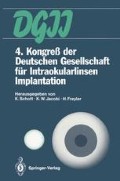Zusammenfassung
Unter Anwendung der computerassistierten Vorderkammerfluorophoto-metrie wurde der Einfluß von Flurbiprofenaugentropfen auf die Blut-/Kammerwasser-schranke nach Phakoemulsifikation und Hinterkammerlinsenimplantation untersucht. Jeweils 10 Patienten erhielten randomisiert Flurbiprofen-0,03%-Augentropfen oder Vehikel am operierten Auge 5mal täglich appliziert. Steroide oder andere, nicht-steroidale Antiphlogistika wurden während des Untersuchungsintervalls weder systemisch, noch lokal therapiert. Die fluorophotometrische Kontrolle erfolgte am Tag vor Operation und am 5. postoperativen Tag. Fluoreszein-Natrium 10% wurde intravenös appliziert (7 mg/kg Körpergewicht). Die Varianzanalyse bestätigte den signifikant protektiven Einfluß von Flurbiprofen-0,03%-Augentropfen auf die Blut-/Kammerwasserschranke nach Hinterkammerlinsenimplantation sowohl am operierten (p<0,001) als auch am nicht-operierten Partnerauge (p<0,01). Die spaltlampenmikroskopischen Befunde stehen in Einklang mit den fluoro-photometrischen Daten.
Summary
Preoperative and postoperative anterior chamber fluorophotometry was performed after intravenous administration of fluorescein sodium in patients undergoing extra-capsular cataract and posterior chamber lens implantation. The administration of topical 0.03% flurbiprofen sodium solution before and after surgery significantly decreased the breakdown of the blood-aqueous-barrier compared with vehicle at each time period, as measured by computerized fluorophotometry. Corticosteroids were not given to any patient throughout the duration of the study. The statistical results (ANOVA) correlated well with the slitlamp observations of postoperative ocular inflammation. The protective influence of flurbiprofen 0.03% natrium solution on the breakdown of the blood-aqueous-barrier was statistically significant (p<0.001).
Access this chapter
Tax calculation will be finalised at checkout
Purchases are for personal use only
Preview
Unable to display preview. Download preview PDF.
Literatur
Adams SS, Buckler JW (1979) Ibuprofen and Flurbiprofen. Clin Rheum Dis 5.
Araie M, Sawa M, Takase M (1981) Effect of topical indometacin on the blood-aqueous barrier after intracapsular extraction of senile cataract — a fluorophotometric study. Am J Ophthalmol 25:237–247.
Araie M, Sawa M, Takase M (1983) Topical Flurbiprofen and Diclofenac suppress blood-aqueous barrier breakdown in cataract surgery: a fluorophotometric study. Jpn J Ophthalmol 27:535–542.
Araie T, Takase M (1985) Effects of S-596 and carteolol, new beta-adrenergic blockers, and flurbiprofen on the human eye: a fluorophotometric study. Graefe’s Arch Clin Exp Ophthalmol 222:259–262.
Bizzotto MF, De Franco I, Carillio F (1984) Efficacy of Flurbiprofen versus Placebo on postoperative course following cataract extraction. Drugs Exptl Clin Res 10:421–425.
Crook D, Collins AJ, Rose AJ (1976) A comparison of the effect of flurbiprofen on prostaglandin synthetase from human rheumatoid synovium and enzymatically active animal tissues. Communications, J Pharm Pharmacol 28:535.
Eakins KE (1977) Prostaglandin and non-prostaglandin mediated breakdown of the blood-aqueous barrier. Exp Eye Res [Suppl]:483–498.
Ehrlich P (1881) Ueber provocirte Fluorescenzerscheinungen am Auge. Versammlung der Charité-Aerzte 10. 3. 1881.
Ferreira SH, Vane JR (1967) Prostaglandins: their disappearance from and release into the circulation. Nature 216.
Flach AJ (1989) Nonsteroidal anti-inflammatory drugs. Ophthalmol Clin North Am 2.
Van Haeringen NJ, Glasius E, Oosterhuis JA, van Delft JL (1983) Drug prevention of blood-aqueous-barrier disruption. Opthalmic Res 15:180–184.
Hillman JS, Frank GJ, Kheskani MB (1980) Flurbiprofen and human intraocular inflammation. Advances in prostaglandins and thromboxane research vol 8. Raven, New York.
Kraff MC, Sanders DR, Jampol LM, Peyman GA, Lieberman HL (1982) Prophylaxis of pseudophakic cystoid macular edema with topical indomethacin. Ophthalmology 89.
Lepper RD, Trier HG (1981) A new device for ocular biometry. Docum Ophthal Proc Series 29.
Maloney WF, Grindle L (1988) Textbook of phacoemulsification. Lasenda, Fallbrook, CA.
Miyake K, Sugiyama S, Norimatsu I, Ozawa T (1978) Prevention of cystoid macula edema after lens extraction by topical indomethacin (III) radioimmunoassay measurement of prostaglandins in the aqueous during and after lens extraction procedures. Graefe’s Arch Klin Exp Ophthalmol 209:83–88.
Miyake K, Asakura M, Maekubo K (1984) Consensual reactions of human blood-aqueous barrier to implant operations. Arch Ophthalmol 102:558–561.
Miyake K (1988) Fluorophotometric evaluation of the blood-ocular barrier function following cataract surgery and intraocular lens implantation. J Cat Refract Surg 14:560–568.
Pham Duy T, Becker HU, Wollensak J, Tievenow N: Einfluß der E.G. Kataraktoperation und Hinterkammerlinsenimplantation auf die Blut-Kammerwasserschranke.
Polansky JR, Weinreb RN (1984) Anti-inflammatory agents, steroids as anti-inflammatory agents. In: Sears ML (ed) Handbook of experimental pharmacology, pharmacology of the eye, vol 69. Springer, Berlin Heidelberg New York Tokyo, pp 459–538.
Sanders DR, Kraff MC, Lieberman HL, Peyman GA, Tarabishy S (1982) Breakdown and reestablishment of blood-aqueous barrier with implant surgery. Arch Ophthalmol 100:588–590.
Sanders DR, Kraff M (1984) Steroidal and nonsteroidal anti-inflammatory agents. Arch Ophthalmol 102:1453–1456.
Sawa M, Araie M, Tanishima T (1983) A fluorophotometric study of the barrier functions in the anterior segment of the eye after intracapsular cataract extraction. Jpn J Ophthalmol 27:404–415.
Author information
Authors and Affiliations
Editor information
Editors and Affiliations
Rights and permissions
Copyright information
© 1991 Springer-Verlag Berlin Heidelberg
About this paper
Cite this paper
Diestelhorst, M., Aspacher, F., Konen, W., Krieglstein, G.K. (1991). Der Einfluß von Flurbiprofen-0,03%-Augentropfen auf die Störung der Blut-Kammerwasserschranke nach Hinterkammerlinsenimplantation. In: Schott, K., Jacobi, K.W., Freyler, H. (eds) 4. Kongreß der Deutschen Gesellschaft für Intraokularlinsen Implantation. Springer, Berlin, Heidelberg. https://doi.org/10.1007/978-3-642-76082-2_15
Download citation
DOI: https://doi.org/10.1007/978-3-642-76082-2_15
Publisher Name: Springer, Berlin, Heidelberg
Print ISBN: 978-3-642-76083-9
Online ISBN: 978-3-642-76082-2
eBook Packages: Springer Book Archive

